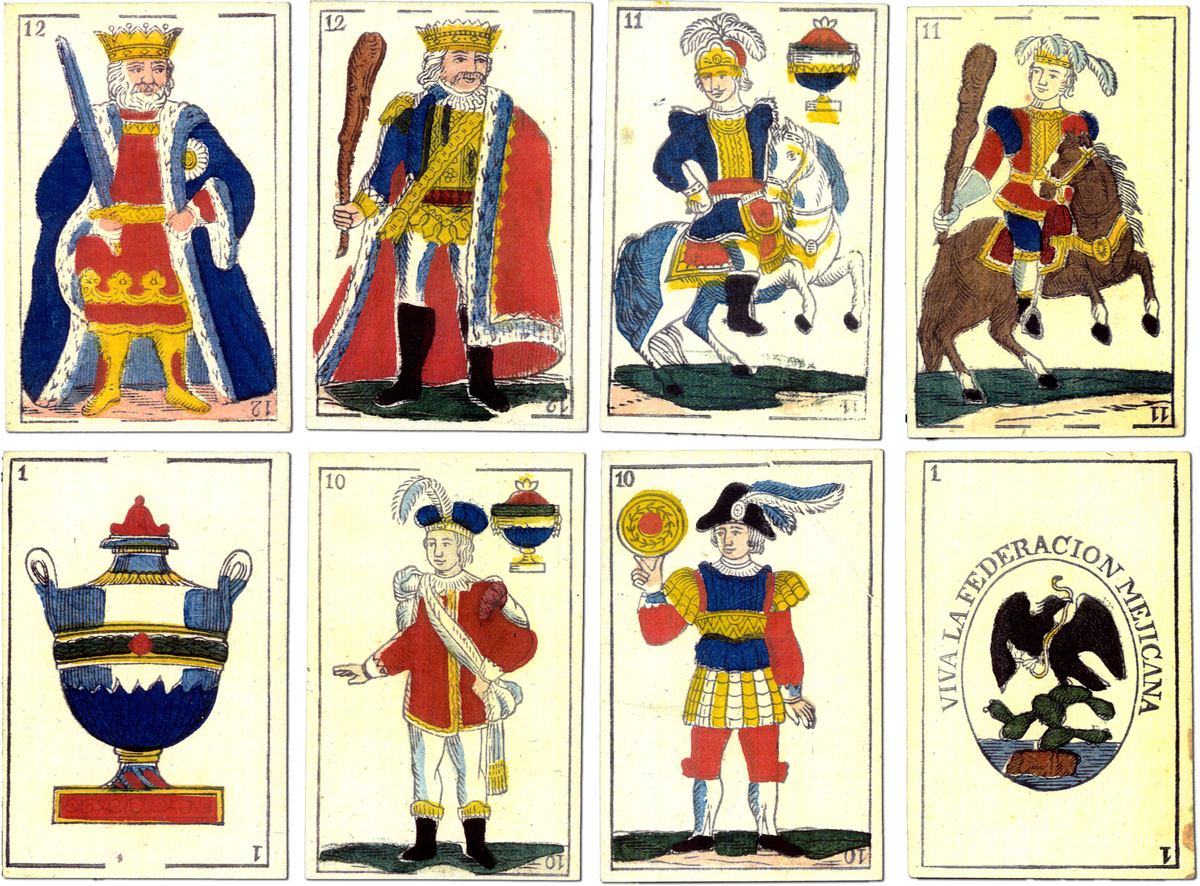Llombart pattern
The Llombart pattern originated in Spain during the early 19th century.
The Llombart pattern originated in Spain
During the early 19th century several Spanish manufacturers were producing finely engraved packs (Clemente Roxas, Josef Monjardín, Martínez de Castro) and Anton Llombart was also in this group, producing several fancy costume packs. This particular design has become known as the “Llombart pattern” as it was copied by manufacturers in several other countries (Belgium, France, Germany, Mexico). As can be seen, all the cavaliers and sotas (Jacks) wear hats with conspicuous feathers and many of the figures wear white breeches.

Above: cards from a pack made by Anton Llombart, Barcelona, dated 1822. © The Trustees of the British Museum number 1896,0501.1343►
Anonymous versions of the Llombart pattern.

Above: cards from a Llombart pattern which is very similar to the Mexican pack (shown below) by an anonymous manufacturer. 48 cards, hand-coloured lithograph, backs printed in blue with a diagonal pattern of small circles formed of dots. © The Trustees of the British Museum • Museum number 1938,0905.1.1-48►

Above: an uncut sheet of 8 playing-cards which correspond with the Llombart pattern executed at Frankfurt for the Spanish market, 19th century. © The Trustees of the British Museum • Museum number 1896,0501.1220►

Above: an anonymous uncut sheet of 20 playing-cards which correspond with the Llombart pattern, 19th century. © The Trustees of the British Museum • Museum number 1883,1110.135►

Cards from a Mexican pack c.1835; maker unknown
These cards are of the 'Plumed Hat' or 'Llombart' pattern and were issued in support of the Mexican Federation. Mexico gained independence from Spain in 1821. One year earlier, a popularist revolution overthrew the newly established Mexican Empire for a federated republic. Numerous civil wars ensued followed by a war against the USA in 1846-8 in which Mexico lost much territory. The particular event, if any, that gave rise to these cards is not known.

Image credit: Dudley Ollis.

By Simon Wintle
Member since February 01, 1996
I am the founder of The World of Playing Cards (est. 1996), a website dedicated to the history, artistry and cultural significance of playing cards and tarot. Over the years I have researched various areas of the subject, acquired and traded collections and contributed as a committee member of the IPCS and graphics editor of The Playing-Card journal. Having lived in Chile, England, Wales, and now Spain, these experiences have shaped my work and passion for playing cards. Amongst my achievements is producing a limited-edition replica of a 17th-century English pack using woodblocks and stencils—a labour of love. Today, the World of Playing Cards is a global collaborative project, with my son Adam serving as the technical driving force behind its development. His innovative efforts have helped shape the site into the thriving hub it is today. You are warmly invited to become a contributor and share your enthusiasm.
Related Articles

Pierre Varangot
Tracing the origins, legality and legacy of Pierre Varangot’s San Sebastián deck.

Archaic Spanish-suited pattern from Bayonne
Archaic Franco-Spanish pattern from Bayonne by a manufacturer with the initals M.V.

Tarot de las Coscojas
Historical playing card design, tarot symbolism and an almost psychedelic medieval surrealism.

Tarot de Valverde de la Vera
A series of 24 surrealist engravings by Mexican artist Claudio Favier in which archetypal Tarot alle...

Baraja de Juan Martín Zamorano
Deck inspired by El Pendón de los Zamorano, a military pennant dating from 1501, published by Priego...

Heráldica Castanyer No. 16
Strange variant of international pattern cards for poker or bridge.

Fantasy Spanish-suited deck
Fantasy Spanish-suited deck by Bertschinger y Codina, Barcelona.

Bertschinger y Codina - Cartes Françaises
French ‘Paris’ pattern made by Bertschinger y Codina, Barcelona, c.1850.

Braulio Fournier
Baraja Nº 1 produced by Braulio Fournier, Burgos, c.1868.

Pirritx eta Porrotx
Happy Families card game from the Spanish Basque Country.

Naipe Vizcaino
‘Naipe Vizcaino’ designed by Javier Urkiri and published by Industrias Gráficas Castuera and the Caj...

Baraja Turística del País Vasco
Basque poker deck of 55 cards published by Fournier with scenic views of the Basque Country.

Baraja Vasca
Spanish Basque Country deck with original drawings by María Isabel Ibañez de Sendadiano.

Baraja Cultura Española
ASESCOIN pack for 2022 designed by M.A. Corella featuring famous Spaniards and notable buildings.

Laurenzo Propagine
Spanish-suited cards made in Italy by Laurenzo Propagine.

Jeu de 7 familles Les Dynasties d’Artisans Basques
Long-standing Basque businesses represented in a traditional card game with illustrations by Odile A...
Most Popular
Our top articles from the past 28 days

